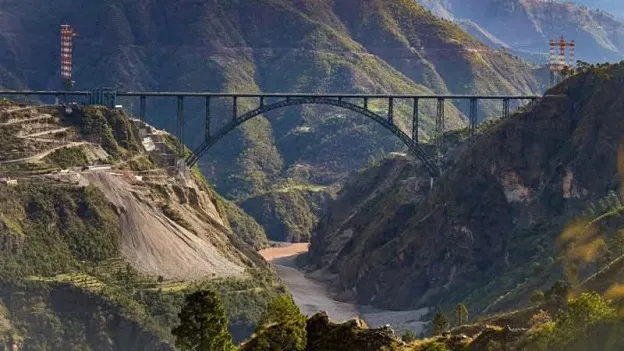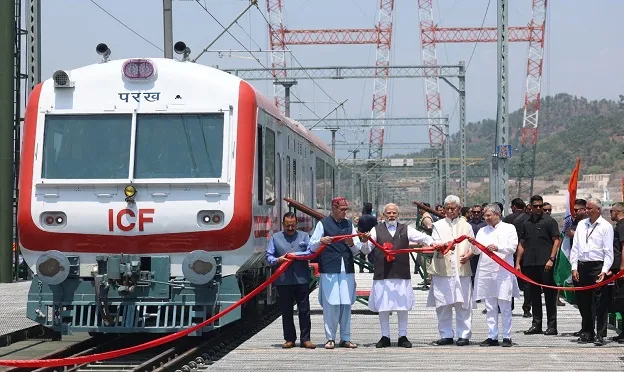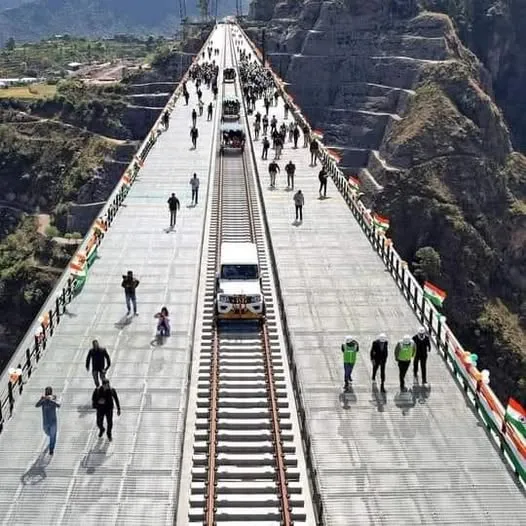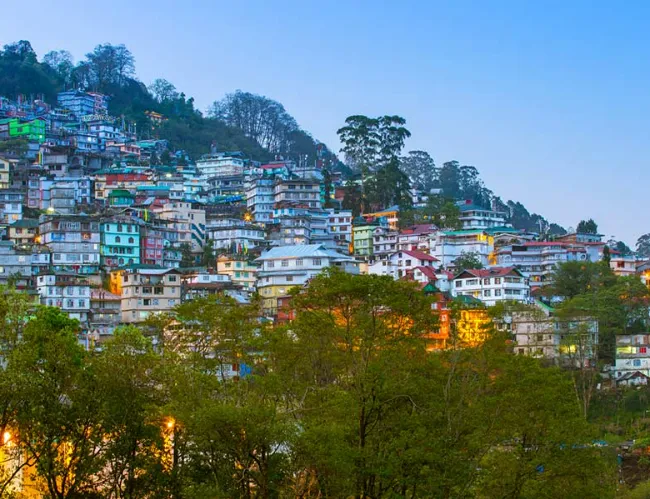The Chenab Rail Bridge, often hailed as the world's tallest railway bridge, is set to be a game-changer not only for Indian railways but also for the tourism landscape of Kashmir. Built over the dramatic Chenab River in the Reasi district of Jammu and Kashmir, this architectural marvel will soon connect the Kashmir Valley to the Indian rail network like never before.

In this blog, we dive into everything you need to know about the Chenab Rail Bridge and how it will impact Kashmir tourism.
What is the Chenab Rail Bridge?
The Chenab Rail bridge is part of the Udhampur-Srinagar-Baramulla Rail Link (USBRL), a strategic railway project aimed at improving connectivity to the Kashmir Valley. The bridge has been designed to withstand:
- Wind speeds up to 260 km/h
- Earthquakes of high magnitude
- Temperature variations from -10°C to 40°C
Location: Reasi district, Jammu & Kashmir
River Crossed: Chenab River
Height: 359 meters (taller than the Eiffel Tower)
Length: 1,315 meters
It's steel and concrete structure is corrosion-resistant and fortified to remain durable through the region’s harsh climate.
Why is Chenab Rail Bridge Important?
Chenab Rail Bridge is the tallest railway bridge globally, surpassing the Millau Viaduct in France.
Strategic Significance: Enhances mobility for both civilians and defense forces.
All-Weather Connectivity: Reduces dependence on roads often blocked by snow or landslides.
Boost to Local Economy: Better access will increase tourism and trade.
How Will Chenab Rail Bridge Impact Kashmir Tourism?
The Chenab Rail Bridge forms an important part of the Iconic Katra–Srinagar Vande Bharat Express Route. A defining moment in Indian rail history occurred on June 6, 2025, when the Vande Bharat Express was inaugurated, connecting Shri Mata Vaishno Devi Katra (SVDK) to Srinagar. This semi-high-speed train route, featuring the Chenab Bridge, reduces travel time to under 3 hours and offers unparalleled scenic views.

Vande Bharat Highlights Along the Chenab Bridge:
Route Distance: Approximately 189 km (272 km after extension to Jammu Tawi)
Travel Time: Approx. 2 hours 58 minutes
Classes: AC Chair Car and Executive Chair Car
Amenities: Wi-Fi, infotainment, ergonomic seating, onboard catering, and advanced heating for cold conditions
Engineering Integration: The route features multiple tunnels and bridges, including Tunnel 33, Tunnel 44, and the Chenab Bridge
The benefits of this for Kashmir Tourism is listed below:
1. Seamless Access to Kashmir: Travelers can now reach Srinagar by train from any major Indian city — a huge shift from the current reliance on air or road transport. This will especially benefit budget travelers and domestic tourists from tier-2 and tier-3 cities.
2. Year-Round Travel: Currently, winter snow and landslides on the Jammu–Srinagar highway often delay or cancel travel plans. With rail access, tourists can visit Gulmarg, Pahalgam, or Sonamarg without road travel hassles.
3. Offbeat Destinations Will Flourish: Smaller destinations like Reasi, Banihal, Kupwara, and Shopian—previously inaccessible to most tourists—will now get attention due to better last-mile rail access.
4. Boost for Homestays & Local Businesses: With increased footfall, local homestays, craft markets, and eco-tourism projects stand to gain significantly. Expect growth in demand for experiential and cultural stays in Kashmir.
5. More Group & Senior Tourism: Train travel is often preferred by senior citizens and group travelers for its affordability and comfort. This could result in new packages and tourism segments.
What Tourists Can Expect?
🚆 Scenic Train Rides: Passengers will enjoy views of the Pir Panjal mountains, deep gorges, and rivers.
📍 New Railway Stations: Modern stations in Baramulla, Srinagar, and Anantnag with tourism information centers.
🧳 Integrated Tour Packages: Travel companies are already planning train+stay+experience combos for Kashmir

Eco and Cultural Impact:
Positive: Increased tourism revenue, employment, and exposure to local culture.
Challenges: Need for sustainable tourism practices to avoid environmental degradation and preserve local traditions.
The Chenab Rail Bridge is not just an engineering wonder — it’s a symbol of unity, access, and economic opportunity. For the tourism industry in Kashmir, it marks the beginning of a new era where nature, culture, and technology converge to create unforgettable travel experiences.
If you're planning a visit to Kashmir in the coming years, prepare to experience the valley by train — across the world’s highest railway bridge.
Most Frequently Asked Question: Is there a vande bharat train from Delhi to Srinagar?
There is currently no direct Vande Bharat Express from Delhi to Srinagar. Travelers must:
Take a Vande Bharat or Rajdhani/Duronto/Shri Shakti Express from Delhi to Jammu Tawi/Katra, then transfer to the Katra–Srinagar Vande Bharat.
How to Reach Srinagar from Delhi by Train?
While there's no direct train from Delhi to Srinagar due to security and geographical constraints, you can reach Srinagar by train with a transfer at Jammu Tawi. Here's how: 1. Delhi to Jammu Tawi
Several trains operate between New Delhi and Jammu Tawi, the nearest major railway station to Srinagar. Some of the prominent options include:
- Rajdhani Express (12425): Departs at 20:40 from New Delhi and arrives at 05:00 at Jammu Tawi.
- Duronto Express (12265): Departs at 22:30 from Delhi Sarai Rohilla and arrives at 07:10 at Jammu Tawi.
- Shri Shakti Express (22461): Departs at 19:05 from New Delhi and arrives at 03:40 at Jammu Tawi.
From Jammu Tawi, you can continue your journey to Srinagar by train. The newly inaugurated Vande Bharat Express connects Jammu Tawi to Srinagar, offering a comfortable and scenic ride through the picturesque landscapes of Jammu and Kashmir.

Train Details:
Train Number: 26401/264·02
Route: Jammu Tawi → Katra → Srinagar·
Journey Time: Approximately 3 hours·
Frequency: Six days a week (excluding Tuesdays· & wednesday)
Classes: AC Chair Car and AC Executive Chair Car·
Amenities: Onboard catering, Wi-Fi, infotainment system, ergonomic seating, and advanced heating systems. Fare Estimates:·
AC Chair Car: ₹1,500–₹1,600·
Executive Chair Car: ₹2,200–₹2,500·
Note: These fares are approximate and subject to change.
FAQs About Chenab Rail Bridge & Kashmir Tourism:
Q: Is the Chenab Rail Bridge open for tourists now?
A: Not yet. It is expected to be open for public rail services by late 2025 or early 2026.
Q: Will the train go directly to Srinagar?
A: Yes, the USBRL project aims to connect Udhampur to Baramulla, with Srinagar as a major stop.
Q: Can I visit Chenab Rail Bridge as a tourist?
A: Once operational, the train will pass over the bridge, but sightseeing access might be restricted due to safety and strategic reasons.
Written by Muzaffar Bhat
Muzaffar isn't your ordinary travel blogger. Hailing from Kashmir, "The Land of Lakes and Gardens," he's a travel industry expert with an M.Com and MAH from Kashmir University and 6 years of experience. Currently a Kashmir Tour Manager at OurGuest, Muzaffar's passion translates into captivating stories and stunning visuals. A camping, trekking, and photography enthusiast, Muzaffar unlocks Kashmir's hidden gems, sharing insightful tips and local knowledge. Join him as he unveils the magic of Kashmir, one adventure at a time. Muzaffar is based in Srinagar, Kashmir.
For a customized Kashmir Tour experience you can contact us at +91-7669503993 or email to contact@ourguest.in




